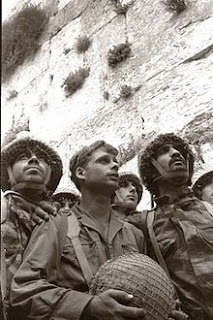CLOSING A 2,000-YEAR CYCLE
King
Herod built the Western Wall in 20 BCE during an
expansion of the Second Temple. When the Romans destroyed the temple in 70 CE,
the support wall survived, which made it the
holiest site for the Jewish People ever since. The
reason it has been dubbed as the “Wailing Wall” is that, for hundreds of years,
people prayed and wept in the small area of the wall that could be seen.
After the 1948 War of Independence, the
Eastern portion of Jerusalem was occupied by Jordan. Under Jordanian control
Jews were completely expelled from the Old City for 19 years, effectively
banning Jewish prayer at the site of the Western Wall.
In 1967, following the Six-Day War, Israelis regained control of
the whole of Jerusalem. Digging below the ground of the wall, they exposed two
more levels. They also cleared the area around the wall, to create the Western
Wall Plaza that visitors see today, and which is open to all people. Since Jews
have been mourning their Temple and
exile for 2,000 years, they come from all over the world to pray at the
“Wailing Wall.”
Every picture tells a story, and for many Israelis, the story of
the Western Wall is told through a picture taken in 1967 by renowned
photographer David Rubinger. This photograph shows paratroopers of the Israeli
Defense Forces staring in awe at the Western Wall in Jerusalem, shortly after
its liberation in the Six-Days War.
Since then, the link between the Western Wall, the Jewish People
and their state is emphasized time and time again when events such as bar
mitzvahs and military inductions are held.
Last Thursday two of my grandsons took part in a swearing-in
ceremony at the Wall and I had the privilege of being one of the proud
spectators. Both grandsons are in the same commando force. One had just finished his basic training and,
together with his co-soldiers, was presented with a gun and a Bible. My second
grandson, who is the commander of one of the two corps of the squadron, gave out the guns to the new soldiers. The ceremony also included two
other squadrons - which made for a very impressive number of soldiers.
Some family members of the newly inducted soldiers had arrived at
three in the afternoon in order to get a place as near as possible to the fenced-off area. The ceremony began at 6:30
p.m. in the very cold and windy Jerusalem air. By 5 p.m. when we were told to
arrive, there were so many people standing on top of each other that the heat most
decidedly rose by a few degrees.


Comments
Post a Comment